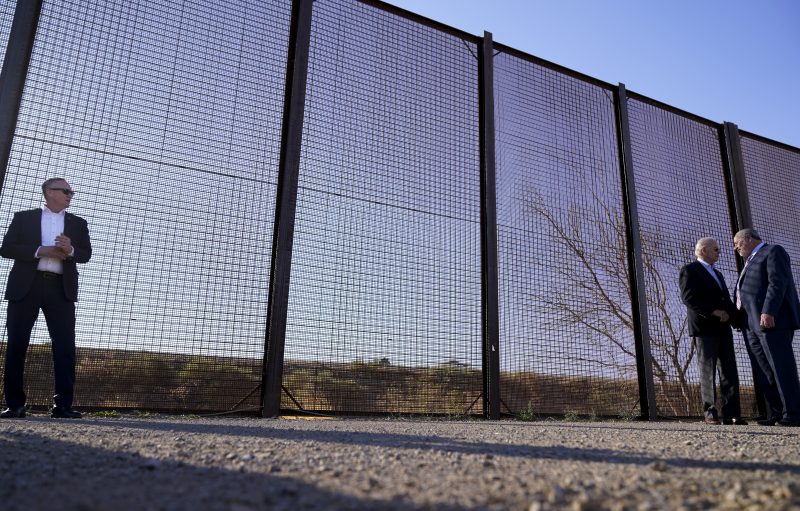For months, President Biden’s critics have agitated for him to visit the U.S.-Mexico border, to see for himself the scale of immigration. Over the weekend, on his way to a summit in Mexico, Biden did so — leading his critics to criticize the visit.
This was predictable, certainly: a photo op that aimed to take a point of attack off the chessboard led to a new point of attack. But it is also a good reminder that Biden’s visit was never going to suddenly open the president’s eyes to the immigration problem because his eyes have almost certainly been wide open for months. The surge in arrivals at the border that accelerated last year is one of the most intractable problems of his presidency and one for which there’s no obvious answer.
Even if you see the problem firsthand yourself.
Part of the problem is that the situation is more complex than Biden’s detractors (and, often, the White House) often admit. Customs and Border Protection collects monthly data on those stopped at the border, and those totals show a marked increase over the past two years.
That spike in 2019 came in May, when there were just over 144,000 encounters at the southern border. (This was the era in which President Donald Trump was most forcefully agitating for an expansion of the border wall.) The last month with fewer than that number of encounters was February 2021. On average, each month since (until November, the most recent month for which numbers are available) has seen 38 percent more encounters than May 2019.
But there’s a giant caveat. When the coronavirus pandemic emerged in early 2020, the Trump administration began a policy in which migrants were turned away at the border under the aegis of a rule purportedly aimed at protecting public health. A new category of border stops was created, ones referred to by the policy section that was argued to authorize them: Title 42.
Since Biden took office, about 43 percent of encounters at the border have been addressed with Title 42, which allows the migrants to be quickly removed from the country. The other 57 percent (of about 4.4 million encounters) were handled under Title 8, the procedure that predates the pandemic.
Notice that the encounters processed until Title 8 have generally come in below the peak in May 2018. But, of course, we’re comparing regular monthly totals with the previous high-water mark. More on that below.
First, let’s look at those Title 42 encounters, which matter for three reasons.
The first is that they allow for the quick removal of migrants, meaning that these are not individuals who then go through the often-laborious process of being evaluated for possible permanent admission to the country. Stories of migrants in shelters or seeking asylum are stories about those processed under Title 8.
But, second, that means that a large number of people seeking entry to the United States are quickly removed from the country … and can simply try to enter it again in short order. This has led to a huge surge in recidivism, people removed from the country who turn around and try again. A chart from a Cato Institute analysis shows the monthly rates at which people who’ve been already been removed over the prior year were stopped attempting to cross back into the United States.
Analysis from TRAC Reports at the University of Syracuse found that 2 in 5 of those removed under Title 42 in the first 19 months of the policy had previously been encountered at the border — and that a quarter of them had been stopped three or more times.
In other words, the monthly encounter numbers are, to some extent, inflated by those making second or third attempts to enter under Title 42. Take away Title 42 and the total number of encounters would likely drop.
Which brings us to the third point. Biden’s political allies have been adamant that the administration should stop the Title 42 policy, arguing — quite reasonably — that the purported health-related justifications are a fig leaf for simply reducing the number of people the government and social-service agencies have to deal with. Efforts to actually unwind the program have been bounced around in federal court, with a ruling last month again upholding the policy.
If we assume that half of those Title 42 encounters would evaporate if the policy was halted (an assumption based on the idea that those stopped wouldn’t be removed from the country and therefore seeking to try to reenter it), we see that the problem gets both better and worse. The total number of encounters falls — from 1.3 million to 950,000 over the past six months of data, for example — but there are now hundreds of thousands more people who need to be processed through the existing system.
Opponents of the administration (or immigration more broadly) often argue that all migrants should simply be stopped at the border. This is easy for pundits to argue but harder for the government of a country in which asylum seekers are legally allowed to remain.
Many of those seeking entry to the United States make asylum claims, an assertion that requires a lengthy, multistep process to adjudicate. Biden can’t simply put up a big wall and keep people from coming in. Over the past six months, for example, about 1 in 10 encounters on average happened at ports of entry — often with migrants turning themselves in to claim asylum.
I know all of this as an employee for The Washington Post nowhere near the U.S.-Mexico border. I am confident that Biden knows this, too, as do his senior aides and advisers. Biden’s visit to the border got him a small bit of rhetorical breathing room and certainly brought him closer to the problem in a literal sense.
It didn’t get him closer to a solution.

